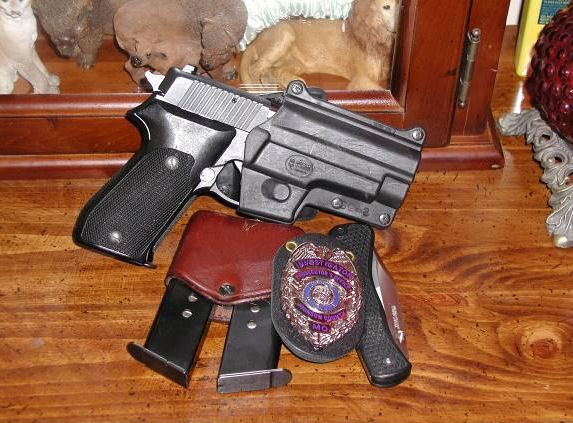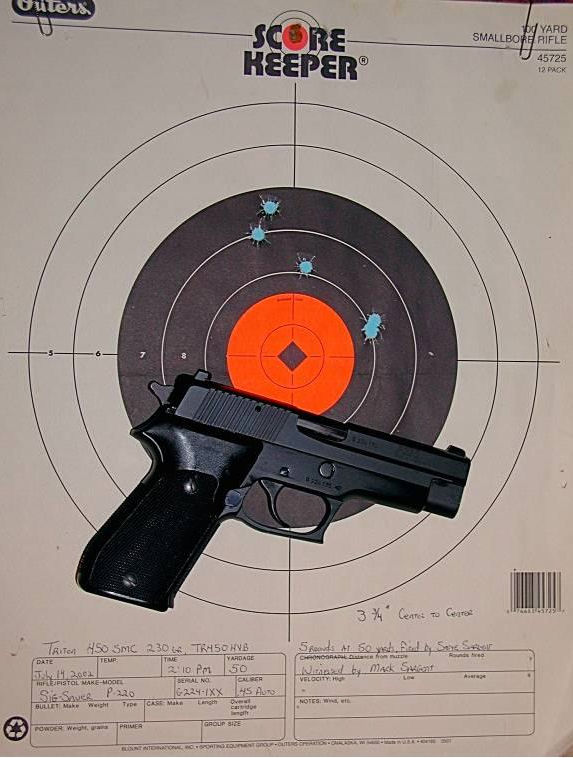The Sig P220 .45 ACP
This gun has made me something of a heretic in certain circles, and completely changed my perspective on what constitutes acceptable accuracy and reliability in a service sidearm. It also inspires me to make one of those broad, sweeping statements that sometimes get me in trouble. So here it goes- Bear defense notwithstanding, if you have a Sig P220 you probably don’t need another handgun.
This splendid design was the brainchild of the German firm Sauer & Sohn, stemming from that company’s efforts to design a new 9mm service pistol for the Swiss army. It was adopted into Swiss service as the A75, in 1975. The gun was loaded with modern features, like a passive firing-pin block safety, a tilting-block lock-up, a de-cocking lever, and a steel modular block that took the beating for the lightweight alloy frame. Sauer soon realized that design was entirely capable of handling the .38 Super and .45 ACP, in addition to the original 9mm chambering. Inroads were being paved to the US market.
As near as I can tell, the “A75” was first imported for US consumption by Hawes Firearms, in 1976. Hawes had already enjoyed a long and successful relationship with J.P Sauer & Sohn, importing a very decent single action revolver (the “Marshal” series) in various popular US calibers. The following year, the big Sauer auto became the “Browning BDA”. These nicely-finished pistols proved a reliable and accurate platform for the full-power auto cartridges. Importation of the pistol under the Browning banner ceased about 1981. American shooters may not have cared for the European “heel latch” magazine release, and after all, it wasn’t a 1911! I was one of those 1911 shooters who nearly missed these fine pistols, because of precisely those prejudices. I had spent my early teen years reading Jeff Cooper, and saw no need for such a contraption.
Luckily, the Swiss firm of SIG was not so blind. It didn’t take long for US importation to begin once again, and very soon the “P220 .45 American” was born. It had the magazine release button right behind the trigger guard, right where we were used to seeing it.
The gun soon received favorable reviews, with Shooting Times’ “10,000-round Torture Test”http://www.galleryofguns.com/ShootingTimes/Articles/DisplayArticles.asp?ID=1230 being among the more notable. More folks tried it, and a few forward-thinking police departments even adopted it. Americans love power, and “+P” .45 loads soon found their way into the new P220. It was found that they were a little much for the envelope, and a few 220’s developed minor frame cracks. In 1994 and at serial number 219,166 Sig-Sauer addressed these problem by strengthening the frame, adding a heavier recoil spring, and adding a rebound feature to the hammer and mainspring that allows it to stand away from the firing pin in the “at rest” position. The current version is fully up to a full diet of ammunition at “full GI hardball” power levels- and in my experience it works best with full-power loads.
The Sig P220 featured in this article is one of the later guns, in the 224,000 serial number range. I picked it up from KY Imports for considerably less than new retail, and gave up nothing in the bargain. Early range outings showed that it was dead-zeroed at 50 yards with any respectable 230 grain .45 load, and that it was not finicky about what it would shoot well. Its excellent single-action trigger made hitting at this distance almost easy. Five shot groups at 25 yards hovered around two inches, and it fed any and all jacketed ammunition offered to it. I finally induced a couple of failure-to-feeds with semi-wadcutter reloads that had been put up in mangled old range brass, which wouldn’t “iron out” in the resizing die. So long as decent cases were used, it would feed those just as well as the jacketed rounds. The Sig remained my daily carry gun for a long time, and I never felt under-gunned as long as it was within reach.
A couple of years ago I learned of an ammunition company called “Triton”, and their recent efforts to pump up the old .45 ACP cartridge. Their answer was the .450 Triton, which was loaded into seriously-strengthened .45 brass which used a small rifle primer. The resulting package launched a 230 grain .45 XTP bullet at 1150 feet per second. Triton indicated that the Sig P220 would handle their new cartridge, so long as a 22-24 pound recoil spring was installed in the gun.
It was the accuracy of the Sig P220 was what inspired me to try the .450 Triton in it. The notion of having a lightweight, top-shelf defensive auto that would do double-duty as a hunting handgun was compelling, so I ordered the heavy-duty springs and some ammo. I really doubted that it would be a great-shooting combination, and I do not advocate a steady diet of such loads in any alloy-framed pistol, regardless of the recoil springs used.
This gun had already produced several sub-4” 50-yard groups with good ball ammo, and it didn’t disappoint me with the .450 Triton load, either. 15 rounds of this stuff didn’t appear to have caused any undue strain on the gun, but as stated above I would reserve it for hunting use only. The target would seem to indicate that it is well-enough zeroed for that application, and 3 ¾” groups indicate adequate hunting accuracy.
Not too shabby, for a powerful service pistol that feeds and shoots well with any good ammo.
I stand by my earlier statement- the Sig P220 is about all the pistol that you need.
A special Thank You goes to “P-220”, one of the fine folks at http://www.sigforum.com/ who provided a comprehensive collection of articles published on the Sig-Sauer P-220 over the years.



Share Your Thoughts